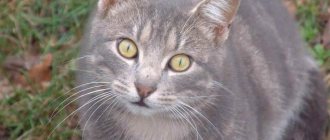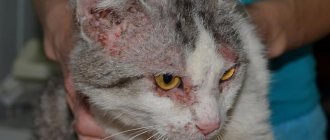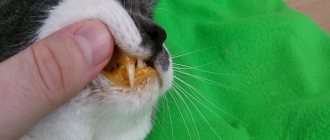Tuberculosis is one of the most dangerous infectious diseases for both humans and animals. The causative agent that causes it is the so-called mycobacteria. This is a genus of aerobic, slow-growing rod-shaped microorganisms, including about thirty species. Most representatives of this genus are capable of causing severe illnesses in vertebrates that are difficult to treat (tuberculosis, leprosy, various mycobacterioses). In this article we will look at tuberculosis in cats, how this disease progresses, characteristic symptoms, danger to others, as well as methods of its treatment and prevention.
General information
Animals get sick mainly in two ways:
- airborne - during contact between sick and healthy individuals;
- nutritional or contact - through contaminated household items, when eating contaminated food, meat or milk of sick animals, as well as during mouse hunting.
The following felines are at risk:
- animals kept in a nursery in poor sanitary and hygienic conditions. They become infected from each other;
- animals with impaired immunity. Their body cannot resist the infection, and they become very ill;
- small kittens and older animals. The disease is transmitted to them more often than to young and strong cats.
Course of the disease
The course of tuberculosis is characterized by two stages - primary and secondary. A cat becomes infected, in most cases, through the lungs, in more rare cases - through the oral cavity, broken skin, and even through the mucous membrane of the eyes. The immune system, when activated, produces antibodies to the pathogen.
A primary focus of inflammation is formed at the site of infection. These are, first of all, the respiratory organs, tonsils, and pharynx. In second place are the skin, intestines, and lymph nodes. Subsequently, the infection spreads through the blood throughout the body, involving other organs and systems in the process. Foci of tuberculosis can also form there. With strong immunity, they encapsulate (heal) over time, and the disease becomes a closed form. The cat becomes a carrier of the infection. In unfavorable conditions (especially during cold periods), with a sharp decrease in immunity in the foci, the process may be activated. The disease will take a generalized form and enter the stage of secondary tuberculosis.
Basic information and symptoms
In general, cats do not get tuberculosis very often, but it does happen. The most common pathogen is Mycobacterium bovis. It primarily affects cattle, but can be equally found in badgers, ferrets, dogs and cats. Cats become infected through consumption of unpasteurized, contaminated cow's milk, or from contact with sick animals or their secretions.
Other mycobacteria that cause tuberculosis can also become a source of the disease. This is, for example, M. Microti. This variety is more common in rodents (eg voles). Cats become infected by eating caught “game”. Oddly enough, this type of disease is especially common in the UK, although this is almost never observed in other European countries. Infection with the avian variety of tuberculosis, which is caused by M. Avium, is extremely rare, but is very severe, with the formation of large cavities in the lungs and other organs.
Since cats most often become ill when consuming milk from sick cows, symptoms of intestinal damage are the first to appear. An inflammatory granulomatous infection develops, leading to diarrhea, vomiting, lack of appetite and weight loss. However, one should not discount the possibility of transmission of infection through contact with other animals, and this is especially true for cocky cats. Their primary clinical signs are wounds that do not heal for a long time, sometimes small ulcers form on the skin, and swelling of the subcutaneous lymph nodes is possible. Sometimes only short-term inflammation indicates the presence of a pathogen in the body.
Since wounds on the neck, head and limbs are very common after cat fights, the first signs of tuberculosis are most likely to be detected there. Swollen lymph nodes in the submandibular area should make you wary and remind you to visit a veterinarian. In some cases, local infection extends far into the subcutaneous tissue, down to the muscles and bones. In this case, severe lameness often develops.
But the disease progresses, and the lungs often become “next on the list” in cats. A heavy, barking cough quickly appears, the animal breathes heavily and wheezes. Most often, cats die at this stage not from tuberculosis itself, but from secondary infections that easily affect an extremely weakened body.
Symptoms of the disease
Feline tuberculosis has symptoms that vary depending on where the infection occurred. Until the generalization of the process occurs, one organ or group of organs that were the first to encounter the action of mycobacteria suffers.
- With the nutritional route of infection (through contaminated meat, milk, or from infected mice during hunting), the intestines are the first to suffer. Tuberculomas (foci of lesions) form there, causing symptoms of intestinal intoxication: diarrhea, vomiting, weight loss.
- When in contact with sick brothers (most often during fights), the first signs of tuberculosis look like non-healing wounds on the skin and enlarged lymph nodes (most often peripharyngeal). Sometimes the infection penetrates deeply and affects the muscles and bones. Skin tuberculosis can occur in one of three forms: focal lesions, nodular subcutaneous tuberculosis or tuberculous tumor-like lesions.
- If an animal receives an infection through airborne droplets, the lungs are affected. Characteristic signs of this form are a persistent barking cough and heavy breathing. Subsequently, pulmonary hemorrhages are possible. Tuberculous pharyngitis may occur, accompanied by inflammation of the tonsils. This form of tuberculosis often resolves with the addition of secondary infections, since the body's resistance drops dramatically.
- Eye tuberculosis has the form of conjunctivitis, complicated by inflammation of the eyelids. In rare cases, it may be accompanied by the formation of tuberculous granulomas on the eyeballs.
- Generalized tuberculosis has the most severe symptoms, as it affects all organs and systems. The most important symptom is a sharp drop in the body's resistance, which is characterized by poor healing of wounds and skin damage. Symptoms of intoxication increase - diarrhea, vomiting, loss of appetite, weight loss, which are combined with increasing weakness, enlarged lymph nodes. At this stage the disease is most contagious.
How does tuberculosis manifest in cats? Is it possible to treat?
Feline tuberculosis is a chronic infectious disease, often accompanied by a proliferative inflammatory process in the intestinal or respiratory tract. Cats are more resistant to infection with tuberculosis than ruminants or pigs.
Etiology
The main causative agents of feline tuberculosis : Mycobacterium bovis Mycobacterium tuberculosis; in some cases, infection with Mycobacterium microti and Mycobacterium avium is possible.
To destroy the pathogen, a 3% formaldehyde solution is used as a chemical disinfectant; 1-2% solutions of phenol also have a detrimental effect on mycobacteria, but phenol is very toxic to cats (!).
Pathogenesis
Cats are infected with the bovine tuberculosis most often through the oral route through milk and slaughterhouse waste, sometimes through the sputum of a patient with an open form of pulmonary tuberculosis in livestock.
Mycobacteria primarily colonize the pharynx or intestines; Airborne droplet or dust infection is also possible with subsequent localization of the process in the lungs, which are also the entrance gates for the infection.
In this case, later it is possible to develop an open form of pulmonary tuberculosis , as is the case in humans and cattle. Infection through skin wounds and the mucous membrane of the eyes cannot be ruled out.
The entrance gates determine the subsequent organ localization of the primary tuberculosis process - the skin, lungs, pharynx, intestines and their regional lymph nodes, including the peripharyngeal, mediastinum and ileocecal region.
When the lymph nodes in the head area are affected, the latter increase in size and, often, the formation of fistulas.
Subsequently, the primary focus is either cured or encapsulated (rarely!), or the pathogen is introduced into other organs and tissues by hematogenous and lymphogenous routes, as a result of which the tuberculosis process becomes generalized.
In addition, tubercles, like in dogs, can be localized on the pleura. Encapsulated foci of caseous necrosis form in the lymph nodes; the latter can also be detected in the liver, lungs, spleen or eye tissue, occasionally in the uterus and joints.
Skin lesions occur relatively often, which is explained by the cat’s constant licking of its fur. the tuberculosis process is localized in the tonsils, pharynx, lungs or intestines, mycobacteria are transferred to the tongue with saliva or paws (with feces) and rubbed into the skin, mainly in the head area (the bridge of the nose, ear, eye circumference and the eye itself).
Symptoms
The type and severity of clinical signs are determined by the phase of the disease and the location of the lesion. When the process is localized in the skin, the lesion is encapsulated, and when localized in the area of the conjunctival sac, treatment is possible due to constant tear production.
In the case of generalization of the tuberculosis process, symptoms of a serious disease are revealed. There is general weakness, depression, lack of appetite, emaciation, incessant diarrhea, and impaired wound healing. Body temperature is usually normal or slightly elevated.
Enlarged lymph nodes are palpated in the abdominal cavity.
In the differential diagnosis, lymphosarcoma should be excluded by performing a biopsy.
When the tuberculosis process to the intestinal wall, signs of ileus appear. Tuberculous nodules are found in the liver and spleen; the spleen is greatly enlarged (splenomegaly).
When the lungs are affected, a chronic dry cough and intense deep breathing are noted; During auscultation, repeating noises are detected.
In cats, the pleura is relatively rarely affected; however, in the case of tuberculous pleurisy, breath sounds and heart sounds become muffled. These percussions are not very characteristic.
An X-ray examination reveals foci of darkening (infiltration) in the lungs, alternating with foci of clearing (marble pattern).
Primary or secondary tuberculous pharyngitis occurs, accompanied by enlargement of the tonsils and peripharyngeal lymph nodes. Foci of swelling form in the skin and subcutaneous tissue, the contents of which are opened in the form of fistula canals.
There are three forms of cutaneous tuberculosis in cats:
- Ulcerative or fistula-exudative focal skin lesion in the intermaxillary region or in the pelvic area originating from the pharyngeal lymph nodes.
- Nodular subcutaneous tuberculosis, observed mainly on the dorsum of the nose of Siamese cats.
Initially, sarcoid nodules form subcutaneously, which then soften and break out, resulting in the formation of an extensive ulcerative surface. - Tuberculous skin “tumors” (tumor-like lesions), localized primarily on the extremities and back.
They look like relatively large (solid) rounded formations that cannot be cured by therapeutic means.
Tuberculous eye lesions occur in the form of tuberculous blepharoconjunctivitis, accompanied by thickening of the eyelids, or in the form of tuberculous nodular iritis or choroiditis; The formation of small fluctuating tuberculous granulomas on the eyeball or in the thickness of the cornea is also possible.
Tuberculous endometritis, accompanied by purulent discharge from the vagina, is relatively rare.
Pathological and histological changes manifest themselves in the form of a focal tissue reaction with pronounced epithelioid cell proliferation. Sometimes foci of necrosis and melting are found, less often sclerosis.
Diagnosis
Antemortem and postmortem diagnosis of feline tuberculosis can be tentatively made by microscopic detection in smears of secretions and excreta (wounds, nasal discharge, conjunctival secretions, pleural punctate, urine, etc.) of acid-fast mycobacteria, stained by Ziehl-Neelsen, as well as by the nature of the tissue changes in the biopsy material and extirpated lymph nodes.
Clinical symptoms such as emaciation, depression, cough, swollen lymph nodes or intractable skin lesions (often ulcers) are the basis for a preliminary diagnosis.
From an epidemiological point of view, the cultivation of mycobacteria with their subsequent typing seems important.
Due to the slow growth of the tuberculosis , this process takes at least 8 weeks.
When making an intravital diagnosis, such facts as the presence of tuberculosis in the owner of the animal or in other animals in the given farmstead, bacteriological detection of the pathogen, including express methods from smears taken from the pharynx or feces, and the condition of infected laboratory animals are important. A negative bacteriological result does not completely exclude the presence of mycobarterial infection. The final diagnosis is based on the complex of data listed above.
To confirm the diagnosis, serological tests and intradermal injection of tuberculin are used. With subcutaneous injection of tuberculin, after 6-8 hours there is an increase in body temperature by 1.5 ° C, sometimes above 40 ° C.
Differential diagnosis
First of all, it is necessary to exclude yersiniosis, leukemia and other tumor-like diseases, eosinophilic and fungal granulomas, as well as the presence of a foreign body. The variety of manifestations of clinical forms of tuberculosis often makes it difficult to make a differential diagnosis.
The prognosis is generally unfavorable.
Treatment
Treatment of cats infected with tuberculosis pathogens is not carried out, since they are dangerous to humans and other animals.
Cats (as well as dogs) suffering from tuberculosis must be killed (euthanasia).
Source: https://doktorvet.com/koshki/kak_proyavlyetsya_tyberkyliyz_y_koshek_mozhno_li_lechit.php
Diagnostic measures
Tuberculosis is diagnosed in cats, as in the case of the disease in humans, using chest radiography and ultrasound examination. Only they make it possible to determine whether there are damage to internal organs and what their degree is. But sometimes, in case of a questionable diagnosis, a clarifying diagnosis is necessary:
- A blood test is needed to identify abnormalities in its composition and a deficiency of certain microelements (characteristic of tuberculosis infection). This is, for example, the presence of anemia and hypercalcemia in the intestinal form of tuberculosis.
- The method of staining microorganisms with special solutions is used (Ziehl-Neelsen method). In this case, their property of reacting differently to certain dyes is used.
- Biopsy and histology of microscopic areas of affected tissue (in particular skin) stained using the Ziehl-Neelsen method are used.
- Animal tissue samples are examined at the biomolecular level using the polymerase chain reaction method.
The research results are analyzed very carefully. If in at least one case there is a small percentage of the probability of infection of the cat, then it is considered presumably sick and is isolated from the rest of the family members.
Diagnostics
Unfortunately, a doctor will not diagnose an animal based on visible signs and symptoms alone. An examination in a good clinic is required, which involves the following steps.
- Ziehl-Neelsen staining of the smear. In order to identify microbacteria in this way, you need a really good specialist who can identify even a small amount of tuberculosis lesions.
- Histology examination, which is part of the smear described above.
- Growing crops in the laboratory. This test allows you to grow the microorganisms found in the smear and study them. Unfortunately, this study takes several months and in some situations will not give results. This diagnostic method is rarely used.
- PCR. The result of this diagnostic method is effective only against some viruses.
As you can see, it is difficult to diagnose tuberculosis in cats. If the doctor succeeds, then he determines the risk of infection for the owner, and then prescribes the best treatment.
Treatment of the disease
All cases of disease in cats must be recorded by the veterinary and sanitary inspection authorities. If tuberculosis is detected in a nursery, it is not recommended to treat the animal. A cat can also be euthanized if it has been infected with a type of mycobacterium that is dangerous to humans.
If a cat is infected with a type of mycobacteria that is not dangerous to humans, it can be treated. Treatment lasts a long time - from several months to several years. Sick animals should be kept away from other family members, including children and animals.
Complex therapy is usually used, prescribing several potent antibiotics. These are broad-spectrum drugs, such as:
- Marbofloxacin;
- Clarithromycin;
- Rifampicin;
- Clofazimine.
Drug treatment of skin tuberculosis is sometimes combined with surgical removal of foci of infection.
People who have been in contact with a sick animal should be observed for some time in an anti-tuberculosis dispensary, as they could become infected from it.
In many cases, treatment is effective, but the overall prognosis of the disease varies from unfavorable to cautious.
Clinical picture
Depending on the location of the lesion and the type of mycobacterium, several types of tuberculosis are distinguished in cattle:
- Pulmonary tuberculosis.
- Intestinal damage.
- Tuberculosis of the uterus and the reproductive system as a whole.
- Tuberculosis of the udder.
- Generalized damage to the body. That is, the infection has spread throughout the animal’s body.
Depending on the location of the source of infection, the animal exhibits different symptoms. In adult animals in the early stages, signs of the disease are erased. In its acute form, the disease develops only in young individuals.
- The temperature rise is constant.
- Loss of weight and appetite.
- Dyspnea.
- Cough with sputum. At the beginning of the disease, the cough is sharp and infrequent, and then becomes more frequent, sometimes with groans. The mucus may contain blood and necrotic tissue.
- When listening to the animal's chest, clear wheezing is detected.
- Severe swelling of the retropharyngeal and submandibular lymph nodes in the neck. May be accompanied by drooling and suffocation.
- If the udder is affected, then when the cow is milked, there may be blood and curdled masses in the milk. The lymph nodes near the udder enlarge, become dense and lumpy.
- In the intestinal form of tuberculosis, foul-smelling diarrhea with bloody or purulent impurities is observed. Diarrhea alternates with constipation and intestinal colic, which cause significant discomfort to the animal. The depletion of the animal's body in the intestinal form of the disease is rapid due to the fact that food is not digested.
- If the animal has a generalized form of the disease, then enlarged lymph nodes throughout the body are added to all the symptoms listed above.
Prevention of the disease
Prevention of tuberculosis consists of one thing: minimizing possible contact with infected animals. To do this, you should not let your pets walk alone. Their diet should not include raw meat or milk from “untested” cows. Such food must be thermally processed. Eating caught mice also creates a certain risk of infection.
Monitoring the state of your pet’s immune system and maintaining sanitary and hygienic conditions for keeping it will allow an attentive owner to protect it from such a terrible disease as tuberculosis.
Routes of transmission of tuberculosis from animals to humans
Tuberculosis is a contagious disease. You can easily become infected from an animal, since the bovine type of tuberculosis is also dangerous for humans.
There are several ways of transmitting infection from animals to humans:
- Airborne droplet. In the open form of tuberculosis, the animal releases microparticles of mucus and mycobacteria into the air. Since the stalls are warm, the Koch bacillus remains viable in the air for a long time. Farm employees can become infected by breathing air.
- Meat, milk. With tuberculosis in cattle, meat and milk contain a large number of viable mycobacterium tuberculosis. If a person consumes meat or milk without heat treatment, it is very easy to become infected with tuberculosis. This is especially true in rural areas, where tuberculosis infection from animals occurs much more often than in the city. IMPORTANT! It is worth remembering that when buying milk on the market from private individuals, a person runs the risk of contracting tuberculosis. Therefore, milk purchased from strangers must be boiled.
- Contact path. If an animal is sick for a long time, it releases a large number of mycobacteria into the environment. The animal's excrement and bedding become contagious. If a farm employee cleaning the cow shed has broken skin, he may become infected.
- A person can also become infected with the avian type of tuberculosis, but the infection will not develop in the same way as when infected with the human or bovine type. Infection of humans from poultry can occur through feathers, water or meat.











